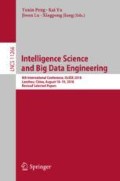Abstract
In this paper, some existing distance-induced similarity measures between hesitant fuzzy sets (HFSs) are firstly verified to have the drawback of low discrimination ability, and thus, we propose some new vector similarity measures between HFSs, which are proved to have stronger discrimination ability than some existing ones in pattern recognition problems by numerical examples validation. Then, a maximum spanning tree (MST) clustering method for HFSs is proposed, based on the vector similarity measures and the fuzzy graph theory. At last, the effectiveness of the proposed method is illustrated by numerical examples.
This work was supported in part by the projects of the former Nanjing Military Region under Grant Number 15MS129, in part by 333 high level talent training project of Jiangsu Province, China under Grant Number [BRA2015527,BRA2017594], in part by the Natural Science Foundation of China under Grant Number 61672292, in part by the Six Talent Peaks Project of Jiangsu Province, China under Grant Number DZXX-037.
Access this chapter
Tax calculation will be finalised at checkout
Purchases are for personal use only
References
Zadeh, L.A.: Fuzzy sets. Inform. Control 8, 338–353 (1965)
Zhang, F., Li, J., Chen, J., Sun, J., Attey, A.: Hesitant distance set on hesitant fuzzy sets and its application in urban road traffic state identification. Eng. Appl. Artif. Intell. 61, 57–64 (2017)
Ye, J.: Multicriteria decision-making method using the Dice similarity measure based on the reduct intuitionistic fuzzy sets of interval-valued intuitionistic fuzzy sets. Appl. Math. Model. 36, 4466–4472 (2012)
Farhadinia, B.: Information measures for hesitant fuzzy sets and interval-vlued hesitant fuzzy sets. Inf. Sci. 240, 129–144 (2013)
Hwang, C.M., Yang, M.S., Hung, W.L.: A similarity measure of intuitionistic fuzzy sets based on the Sugeno integral with its application to pattern recognition. Inf. Sci. 189, 9–109 (2012)
Ye, J.: Cosine similarity measures for intuitionistic fuzzy sets and their applications. Math. Comput. Model. 53, 91–97 (2011)
Sun, G., Guan, X., Yi, X., Zhou, Z.: Grey relational analysis between hesitant fuzzy sets with applications to pattern recognition. Expert Syst. Appl. 92, 521–532 (2018)
Torra, V.: Hesitant fuzzy sets. Int. J. Intell. Syst. 25, 529–539 (2010)
Torra, V., Narukawa, Y.: On hesitant fuzzy sets and decision. In: The 18th IEEE International Conference on Fuzzy Systems, Jeju Island, Korea, pp. 1378–1382 (2009)
Zhang, N., Wei, G.W.: Extension of VIKOR hesitant fuzzy set. Appl. Math. Model. 37, 4938–4947 (2013)
Arora, R., Garg, H.: A robust correlation coefficient measure of dual hesitant fuzzy soft sets and their application in decision making. Eng. Appl. Artif. Intell. 72, 80–92 (2018)
Xia, M.M., Xu, Z.S.: Distance and similarity measures for hesitant fuzzy sets. Inf. Sci. 181(11), 2128–2138 (2011)
Dice, L.R.: Measures of the amount of ecologic association between species. Ecology 26(140), 297–302 (1945)
Jaccard, P.: Distribution de la flore alpine dans le Bassin des Drouces et dans quelques regions voisines. Bull de la Sociètè Vaudoise des Sciences Naturelles 37(140), 241–272 (1901)
Salton, G., McGill, M.J.: Introduction to Modern Information Retrieval. McGraw-Hill, New York (1987)
Chaira, T.: A novel intuitionistic fuzzy \(C\) means clustering algorithm and its application to medical images. Appl. Soft Comput. 11, 1711–1717 (2011)
Kumar, N., Nasser, M., Sarker, S.C.: A new singular value decomposition based robust graphical clustering technique and its application in climatic data. J. Geogr. Geol. 3, 227–238 (2011)
Nikas, J.B., Low, W.C.: Application of clustering analyses to the diagnosis of Huntington disease in mice and other diseases with well-defined group boundaries. Comput. Methods Programs Biomed. 104, 133–147 (2011)
Zhao, B., He, R.L., Yau, S.T.: A new distribution vector and its application in genome clustering. Mol. Phylogenet. Evol. 59, 438–443 (2011)
Zhao, P., Zhang, C.Q.: A new clustering method and its application in social networks. Pattern Recogn. Lett. 32, 2109–2118 (2011)
Bhutani, K.R.: On automorphism of fuzzy graphs. Pattern Recogn. Lett. 9, 159–162 (1986)
Mordeson, J.N.: Fuzzy line graphs. Pattern Recogn. Lett. 14, 381–384 (1993)
Zahn, C.T.: Graph-theoretical methods for detecting and describing gestalt clusters. IEEE Tran. Comput. 20, 68–86 (1971)
Chen, D.S., Li, K.X., Zhao, L.B.: Fuzzy graph maximal tree clustering method and its application. Oper. Res. Manag. Sci. 16, 69–73 (2007)
Zhao, H., Xu, Z.S., Liu, S.S.: Intuitionistic fuzzy MST clustering algorithms. Comput. Ind. Eng. 62, 1130–1140 (2012)
Atanassov, K.T.: Intuitionistic fuzzy sets. Fuzzy Sets Syst. 20, 87–96 (1986)
Chen, N., Xu, Z.S., Xia, M.M.: Correlation coefficients of hesitant fuzzy sets and their applications to clustering analysis. Appl. Math. Model. 37, 2197–2211 (2013)
Gaertler, M.: Clustering with spectral methods. Master’s thesis, Universitat Konstanz (2002)
Kruskal, J.B.: On the shortest spanning subtree of a graph and the traveling salesman problem. Proc. Am. Math. Soc. 7, 48–50 (1956)
Prim, R.C.: Shortest connection networks and some generalizations. Bell Syst. Technol. J. 36, 1389–1401 (1957)
Author information
Authors and Affiliations
Corresponding author
Editor information
Editors and Affiliations
Rights and permissions
Copyright information
© 2018 Springer Nature Switzerland AG
About this paper
Cite this paper
Wu, M., Xu, H., Zhou, Q., Sun, Y. (2018). Vector Similarity Measures About Hesitant Fuzzy Sets and Applications to Clustering Analysis. In: Peng, Y., Yu, K., Lu, J., Jiang, X. (eds) Intelligence Science and Big Data Engineering. IScIDE 2018. Lecture Notes in Computer Science(), vol 11266. Springer, Cham. https://doi.org/10.1007/978-3-030-02698-1_41
Download citation
DOI: https://doi.org/10.1007/978-3-030-02698-1_41
Published:
Publisher Name: Springer, Cham
Print ISBN: 978-3-030-02697-4
Online ISBN: 978-3-030-02698-1
eBook Packages: Computer ScienceComputer Science (R0)

